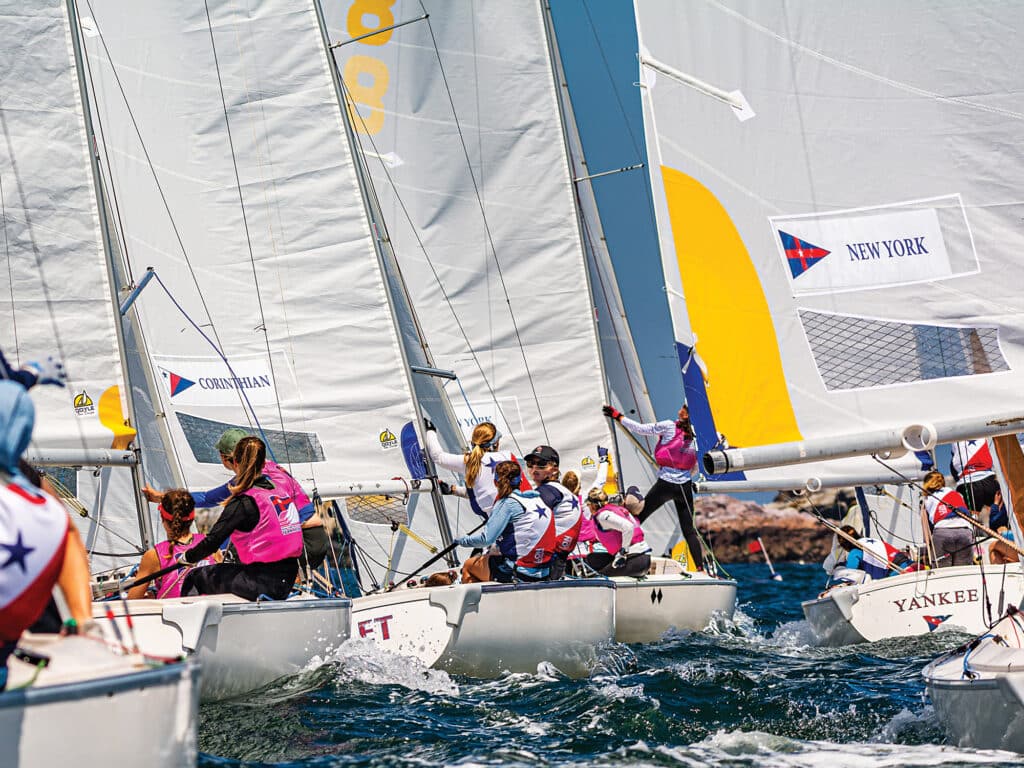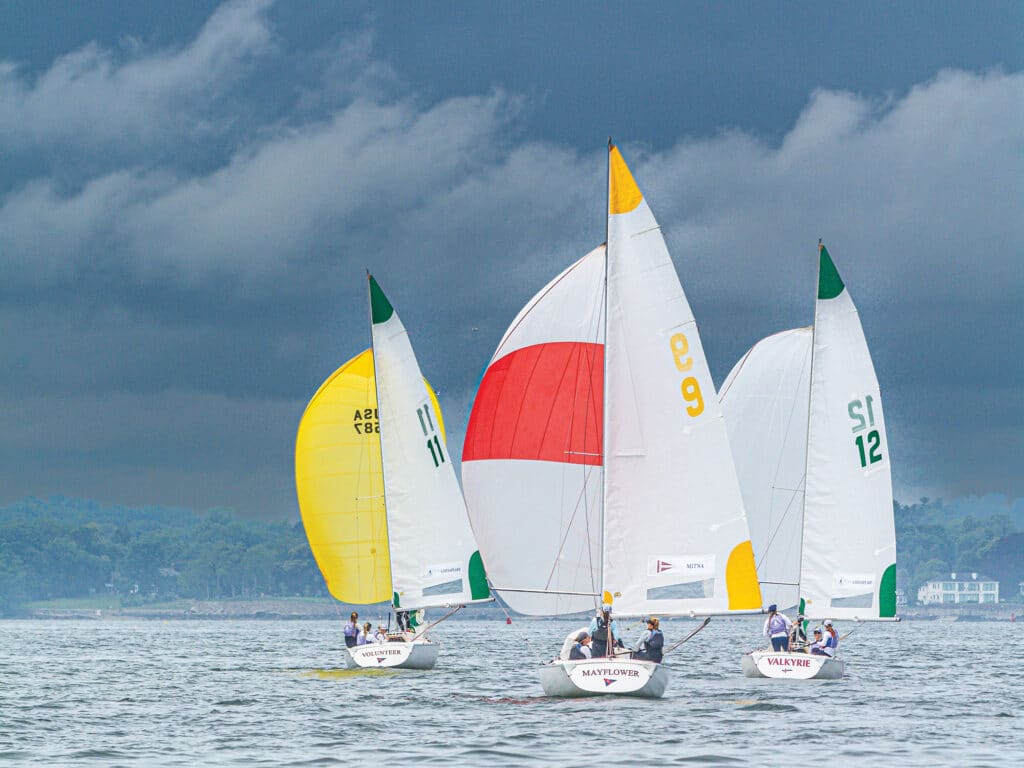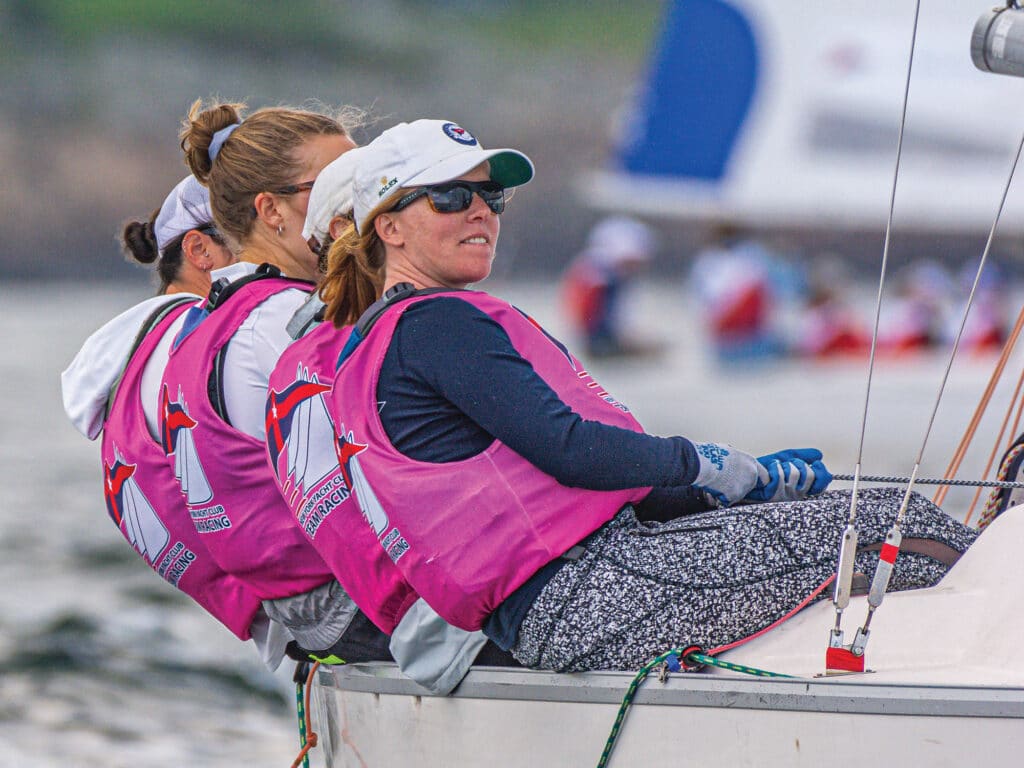
I’m kicking myself because I’m late for the first start—there’s a lot of current for 5 knots of breeze, and my timing to the line is way off. I’m last across the starting line. I’m “Deep 6.”
But this is three-versus-three team racing, so I’m not alone. Ahead, my teammates are scheming how to advance me to the front. They round the first windward mark in second and third. They’ve done their job well, and my crewmates and I claw our way forward. Having practiced how to convert this losing combination, they immediately slow the pace of the race and consolidate against our opponents’ 4-5 positions as we round mark two of the box-shaped racecourse and turn downwind.
If you’re unfamiliar with “3v3” team racing, pay attention because there’s a lot going on as this plays out: Because I am in sixth—and last—place, I’m in better proximity to cover my opponents, but the real gain will be made at mark three. My teammate Ashley Love and her crew are in second place, known as “the 2” in team racing. Meanwhile, once inside the two-boatlength zone (two is standard for team racing), our teammate Janel Zarkowskey and her crew obstruct the opposing team’s 4-5 combination without losing control of either boat. The inside opponent is forced to slow and honor Zarkowskey’s mark-room. The other boat must avoid Zarkowskey and sail extra distance around the outside. The extra maneuvers slow my opponents while I sail past the mark with speed. We are now in a stable winning 2-3-4 combination and notch our first race win—and impressive “double passback”—in the 12-minute race.
After the race, I apologize to Zarkowskey for the hiccup in our start. “This is why we race as a team,” she replies.
With us on this drizzly and still morning in Marblehead Harbor are seven other teams, all in Sonars. We are all here for the National Team Race Invitational for the Thayer Trophy, hosted by Corinthian YC. We have 42 races to finish to complete the double round robin over the next two days. My team, a crew of Chesapeake Bay sailors, is sailing for the Chesapeake Bay Yacht Racing Association. For the third year in a row, Love, our team captain, has secured a grant through CBYRA to cover having 12 of us here, representing the entire Chesapeake Bay community. We’ve competed in this event ever since Corinthian first hosted it three years ago, and we’ve been practicing for it for the past three months. The Gibson Island Yacht Squadron and member Tom Price have been providing generous access to their club-owned Sonars every Monday night; Price ensures the boats are race-ready and even sets marks for our self-organized practices.

Before each Monday practice, Love sends out a call to around 65 sailors from Annapolis, Baltimore, and Washington, DC. Over 12 weeks, men and women with a range of team-racing, keelboat and dinghy experience come to help us build a team and train for the event. This is an intricate and dedicated community effort, and this Thayer Cup is what brings us all together. “The Thayer brings sailing back to a sport with actual teams that people can root for,” Love once told me. “Teams, as opposed to individuals, who are spending time practicing and proving themselves to their clubs or associations. Ultimately, building a team that represents something.”
In our case, we are working to build a women’s team of competent team racers and keelboat sailors. We practice boathandling in the Sonars, try out different crew positions, run passback drills, and orchestrate textbook team-racing combinations. For some, this is an introduction to team racing. Others enjoy the chance to try new positions for the first time. I’m here to improve my team-race and keelboat skills, and this year, I’m here to win the Thayer Trophy. Having placed second and third in the previous editions, this time I think we might actually be able to win this thing.
But we’re not the only team that’s been training hard. No one is at the Thayer to give team racing a try—it’s an invitational, after all. Through a careful selection process, the Thayer Trophy pulls in the top women’s team-race talent, and in his opening remarks, Corinthian’s commodore, Jim Raisides, gives me chills with his on-point message. “We wanted to create the most competitive three-versus-three with spinnaker women’s team-racing regatta in the country,” he says. “We really felt the opportunity to get incredible talent in the room, intense competition, with something everyone would want to circle on their calendar for the regatta that can’t be missed.
“The first thing was, let’s make this the one that everyone will support, let’s make this the one that everyone spends some time actually practicing for, let’s make this the one that you make that phone call to that bow person you can’t live without and say, ‘Can’t you just miss that wedding to go to the Thayer?’ And hopefully, it’s the one that, by preparing all this time in your local harbor, you strengthened team racing in your area just by the fact that you prepared, practiced and introduced new people to it or brought people back to the sport.”
This is exactly the case for all of us. We are surrounded by All-Americans, Olympians and national champions. As Raisides speaks, top female sailors from around the country nod heads in agreement. One thing is certain: The excitement for team racing has attracted many talented sailors to this harbor, and we’re all prepared to win.
It’s no surprise then that the racing is tight. After the first day, we are in a four-way tie for second, and Rhode Island’s Bristol YC is in the lead with one extra win. Over wine with my team on Saturday night, we all agree that this is the most competitive Thayer Trophy field yet. This is no coincidence. Miranda Bakos, the regatta chair, says that over the last two years, the event “has been in a growth phase as teams built out their programs, most of which started women’s keelboat team-racing programs from scratch. Now the bar has been raised, and everyone is competitive. It’s less about learning and more about perfecting and executing.”

It is difficult to understate the nature of participating in a team-race regatta with more than 80 competitors, an all-female team of umpires, and countless race-committee volunteers and event support. We enjoy dinner together, socializing with women of like minds and enjoying the view of Marblehead Harbor. The band has us dancing on the deck until they stop taking our requests. Whether it’s the music, the exhilaration of team racing, or the crisp glass of rosé, the camaraderie is strong. We are celebrating more than the day’s racing. We are celebrating the work we put in to get here, the support from our communities and clubs, and that together we are part of something greater.
Day two brings Champagne team-racing conditions. My team finishes the second round robin with a score of 6-6. Having lost to a few teams we bested in the first round robin, I’m unsure whether we’ll qualify for the gold round. The top four of seven teams advance, and we know two of those spots are taken by Bristol YC and California’s Newport Harbor YC, which are tied for first with eight wins apiece. That leaves two more teams to advance.
Crackling over the radio, the race committee announces the standings. We lean in to listen, the anticipation hanging heavy in the building breeze. It’s a three-way tie for third: my team, Marblehead’s Eastern YC, and the team from Boston’s MIT Nautical Association. Due to the tiebreaker, one of us will not advance. The race committee then announces that it’s not a clean tiebreaker because we each have a win and a loss to each other across the two round robins. This means the tiebreaker comes down to the places we scored in each race—a nerve-racking cliffhanger. Hanging on to every word coming from the radio while searching my memory for how we placed in each race, we finally hear that we’re fourth. We’re the last team to advance to the gold round. Relief quickly morphs to motivation. We have nothing to lose now.
With scores carrying over from the double round robin, we sit two points behind Newport Harbor and Bristol. Each win in the gold round is worth two points, which means we need to win all three of our races. In our first race against Bristol, we’re outmaneuvered and handedly beaten. Winning is out of the cards for us. Nonetheless, we rally in a close one against Newport Harbor right after and add two points to our score. Finally, it’s our last race of the regatta. We round mark one with a 2-3-4 against MITNA but lose “the 4” on the downwind through a double cover. I manage to sail straight and fast, barely entering the mark zone ahead to get “the 1.”

Now my job is to pass my teammate ahead. Boosted by a series of boathandling issues from our opponent in “the 2,” we gain a solid hold on the race. It is super close racing, but we beat MITNA to earn ourselves two more points. We have at least clinched third overall, with the final standings determined by the last race.
Our future now depends on what transpires between Bristol and Newport Harbor. Bristol is over early at the pin and red-flagged by the umpires, meaning they must restart and exonerate themselves with a two-turn penalty. This puts them in the Deep 6 right off the bat. Newport rounds mark one with a 2-4-5 combination to Bristol’s 1-3-6. This race will come down to which team is able to execute its passback more effectively as they attempt to convert to more stable winning combinations. On the short leg between marks one and two, Newport converts to a close 2-3-4, but the race has now slowed enough that Bristol’s Deep 6 is back within striking distance.
Newport holds the 2-3-4 on the downwind, but things get interesting from mark four to the finish. Newport finishes in “the 1,” and while only 50 yards from the line, a Bristol teammate turns her attention behind and begins to aggressively slow her opponent, allowing her teammate to move forward. Meanwhile, on the right side of the course, the third Bristol team manages to pin their opponent, preventing them from tacking until they’re on layline to the finish, beating them to the finish by mere inches for a 2-3-4 race win.

Newport Harbor’s loss in the final race means we tie them for second overall. But because we beat them in our gold-round head-to-head race, we win the tiebreaker and claim second overall. While I had high hopes of winning this year, I am smiling. This is a fantastic outcome for us. Bristol YC demonstrated their deserving position atop the podium, having won all their gold-round races. After a weekend of hard-fought team racing, they are the clear winner.
“This was the most competitive year we’ve seen,” Bristol’s Dani Neri says afterward. “There were no giveaways. Our three losses in the double round robin actually went to the three teams who didn’t end up qualifying for the gold division.”
The Thayer Trophy was created to honor Joan Thayer and her mother, Ellie, for their “decades of breaking ground for women’s sailing,” Raisides says. And Joan is still plenty active in Marblehead’s sailing scene. “If it’s got a sail in it, Joan is going to race it, and she’s going to be fast,” Raisides adds.
Enjoying a bowl of clam chowder and a beer before the awards ceremony, I find myself standing next to Joan and ask her what makes women’s sailing different these days. Without skipping a beat, she says: “Women are stepping up and not shying away. They’re saying yeah, and the clubs are giving them their support. This is what it’s about for me.”
With more women’s events popping up in the last three years, we are seeing this trend expand across the sport. After all, women are the largest untapped pool of sailors. “The fact that this event requires clubs to pull together 12 to 15 women is incredible because a lot of clubs don’t have or didn’t have that many available,” Bakos says. “Creating that excess of opportunity for women is the driving force that sailing needs. A lot of times, women get pigeonholed into certain roles on the boat. This event gives women the opportunity to try new roles, to get repetition and build confidence.”

Invitations for the Thayer are issued to teams provided that at least 70 percent are from the invited yacht club or sailing organization. “This fosters community-based enthusiasm,” Bakos says. “It may mean introducing more seasoned keelboat sailors to the sport of team racing, or allowing recent college graduates with team-race experience the opportunity to step onto a keelboat. Either way, yacht clubs are asked to place a focus on cultivating their women’s talent.”
Only three years ago, Corinthian barely had three drivers, but today it has tripled its roster. At Newport Harbor, I’m told, more women are stepping up to participate in team-race practices. By creating the need for more skilled positions, women are enthusiastically filling those roles. The objective of the Thayer is certainly taking effect and serves as an example to all sailing groups to the benefits of supporting and prioritizing their women sailors financially, providing boats, running club practices and hosting events.
In three years, the Thayer Trophy has raised the level of women’s team-racing tenfold. The excitement for me is being on the helm for high-energy, fast-paced racing. I’m motivated to put in the time and enjoy the process of learning team-racing moves, improving my plays, and reinforcing my understanding of the rules. I am inspired by the thought of winning this high-caliber event someday, and I’m confident our team will return even stronger next year. And when that happens, I won’t be late for the start.









